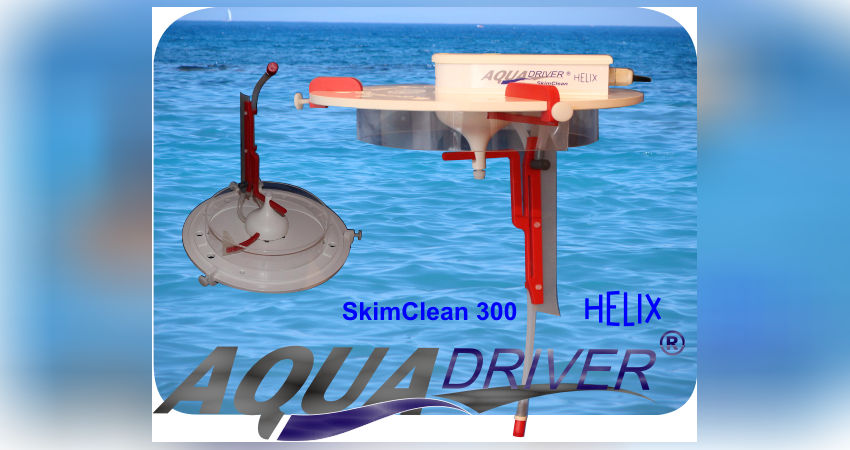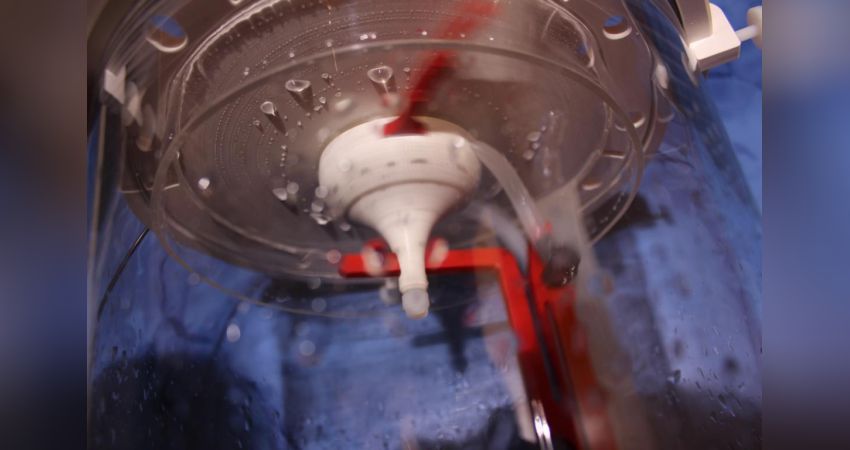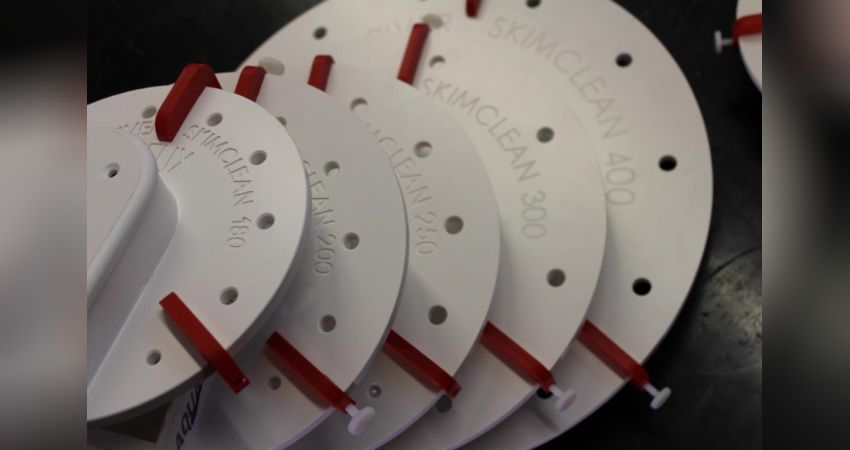SkimClean HELIX, the new high-end skimmer cleaner from AquaDriver

The successor to the hydromechanical SkimClean foam tank cleaner will soon be available. The original SkimClean was first introduced by Royal Exklusiv at Interzoo in 2008 and is now used by passionate saltwater aquarists worldwide to improve performance and ease maintenance. You can now find out more about the Skim Clean HELIX here.
Carsten Prang is the inventor and owner of Aquadriver. He has already made a name for himself several times in the past 13 years. For example, for the first time in 2002 and later, when he introduced and marketed the stream distributor, among other things. (Link to look it up)
It is therefore a pleasure to present something new from Carsten Prang's think tank.
The SkimClean HELIX, the new high-end skimmer cleaner from AquaDriver
.The successor to the hydromechanical SkimClean foam pot cleaner will be available shortly.

The original SkimClean was first introduced by Royal Exklusiv at Interzoo in 2008 and is now used by passionate saltwater aquarists worldwide to enhance performance and ease maintenance.


Here are the most frequently asked questions about the new SkimClean HELIX to Carsten Prang, the developer and owner of AquaDriver.
1. What are the main differences to the previous model?
.Our new SC Helix is the only contact tube cleaner on the market with an additional internal lid cleaning system that also works hydromechanically. In addition, at the suggestion of some customers, the height of the drive was significantly reduced, as some cabinets did not have the necessary height for the previous model.
2. What does hydromechanical cleaning actually mean?
The silicone wipers for the contact tube and the cover are supported by an integrated peristaltic pump and rotating spray nozzles. The water is extracted from the protein separator itself and wets the surfaces to be cleaned with seawater. By using its own water, all surface tensions in the contact tube and inner lid remain constant. This is extremely important, because it keeps the sensitive and stiff foaming stable. The shear capacity remains almost constantly efficient.
If one now compares the fluctuating shear capacities in the normal operating mode, enormous increases in performance are possible. 3. How large are these power increases? The problem of performance degradation due to the build-up of sediments is as old as the technology of protein removal in marine aquaristics. Since the deposits consist of the same protein mix as the foam boundary layer to be removed, coalescence occurs, i.e. build-up that impairs or even prevents further operation. Manual cleaning is necessary and then it takes time for the foam to form and remain satisfactory for some time. Then this process starts all over again and the operating performance continuously decreases. This constantly repeating process is completely overturned by the hydromechanical cleaning, so that up to 60% performance increase is possible due to the now gained effects. 4. How often do I still have to clean the skimmer with SkimClean? As a rule, the cleaning interval is stretched by at least a factor of 4. If, for example, the skimmer was maintained or cleaned weekly, monthly maintenance will now be sufficient. I am also aware of much longer intervals, up to several months, with constant performance of the shearer. There is no general answer to this question, as each pool has its own load intensity. Personally, I know of users who only clean the washer every 3 months and still have hardly any loss of performance. 5. For which protein separators is the SkimClean HELIX available? Almost all protein skimmers with cylindrical foam tubes can be easily cleaned with the SkimClean HELIX. This is made possible by the adjustable main wiper and the various lid sizes. A SkimClean 200 HELIX, for example, is suitable for a skimmer pot with a diameter of 200mm. An SC 250 HELIX is suitable for 250 mm pots, etc. 6. 6. What is a ring sewage line (RSL)? The RSL has nothing to do with the function of the SkimClean and is an optional extra. This ring line has several drain holes and can be fed, for example, from the waste water line of an osmosis system. The pot contents are then rinsed by the injected water practically free of charge, the contents are evaporated and discharged. The waste water pot should always have a connection to a drain. For operation, a pressurised water connection (e.g. from the osmosis waste water) and a drain pipe connected to the pot drain are of course necessary. 7. When will the new SkimClean HELIX be available? I think that we will be able to deliver the first series models in the course of February. The VIDEO: The link to the manufacturer must not be missing: http://www.aquadriver.de/ with salty greens from the Coral Reef Team How do you like this article?
Info
Author

Bookmark
Comments
Topics
Similar articles
- Wir stellen vor: Die neue T5 Leuchtenserie Stealth von Sfiligoi
- Press release: The new Soft Protein Super Food from FaunaMarin
- Product presentation: The Kamoer F4 dosing unit Wifi
- Gesund und schlank mit der ALGENKÜCHE
- Various fish feeders presented
- Easy - Life....ein flüssiges Filtermedium
- Press release - new odour filter for skimmers
- Press Release: AQZENO Professional Reef Salt - Premium Quality
- New on the market: The reefdoser EVO 1 - 3 - 5 from Aqua Medic
- Video: the new Nero 5 from Aquaillumination
Comments To the top
Wäre schön, wenn man am Anfang des Artikel kurz für unwissende beschreiben könnte, was das Ding den überhaupt tun soll. Ich kenne es nicht, und nach ca. 1/4 hab ich die Lust verloren weiterzulesen.
Grüße
Michael
aber in der Ankündigung steht doch dick und fett..
"SkimClean HELIX, der neue High End Abschäumerreiniger"
vg
Robert
erst einmal meinen Dank an Dich, Deine redaktionelle Arbeit und der Möglichkeit der Vorstellung des neuen SC Helix hier !
Hallo Peter,
vielen Dank....man glaubt gar nicht wie viel Mühe dieses Video gemacht hat. Da ich so etwas selbst nicht kann habe ich es allerdings machen lassen. Die Euphillia am Anfang und der neue Helix sind dann doch von mir.
Hallo Kugelfisch,
ein SkimClean Helix fängt für die 160mm und 180mm Modelle bei 419 Euro an und endet bei 599 Euro für sehr große 500mm Abschäumer. Die optionale Ringspülleitung liegt immer bei 98 Euro.
Damit liegen die Endpreise, trotz Zusatznutzen bei rund 20% unter den herkömmlichen Preisen für das ursprüngliche SkimClean Modell.
Genaues dazu beantworte ich gern unter info@aquadriver.de
Viele Grüße
Carsten
Es ist vollbracht und das Warten hat ein Ende.
Alle notwendigen, extern gelieferten sowie für uns gefertigten Bauteile haben Ihre Bestimmung in unserem neuen SkimClean Helix gefunden. Die Geräte der Serie sind einzeln erfolgreich getestet und Vorbestellungen sind bzw. werden umgehend ausgeliefert.
Das Gerät wird direkt über uns....
www.aquadriver-shop.de
....und einem ausgewähltem Kreis renommierter und autorisierter Fachhändler vertrieben. Unser Händlerkreis wird kurzfristig mit allen notwendigen Information versorgt.
Ich für meinen Teil freue mich sehr und bin auch etwas erleichtert, dass die jahrelange Entwicklungsgeschichte dieses hydromechanischen Systems nun eine neue Reife und Effizienz erreicht hat.
Auch gilt mein Dank den zahlreichen hilfreichen Usern, die mit Ihren Ideen und Erfahrungen nicht unerheblich am Erfolg des SC Helix mitgewirkt haben.
Ebenso danke ich Klaus Jansen / Royal Exclusive der der Sache schon damals, bei dem Urmodell aus Überzeugung die gewisse Starthilf gab.
Leistungseinbußen aufgrund von Absorbatanhaftungen und Beeinträchtigungen durch Oberflächenspannungsänderungen gehören aufgrund der feuchtmechanischen SkimClean Reinigung nun der Vergangenheit an.
Viele Grüße
Carsten
Please register
In order to be able to write something yourself, you must register in advance.











